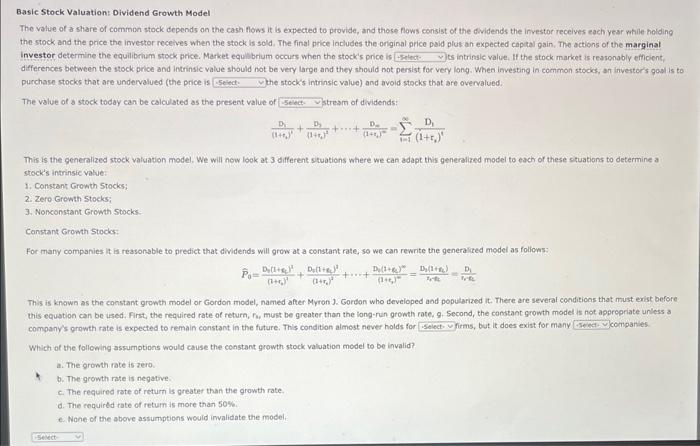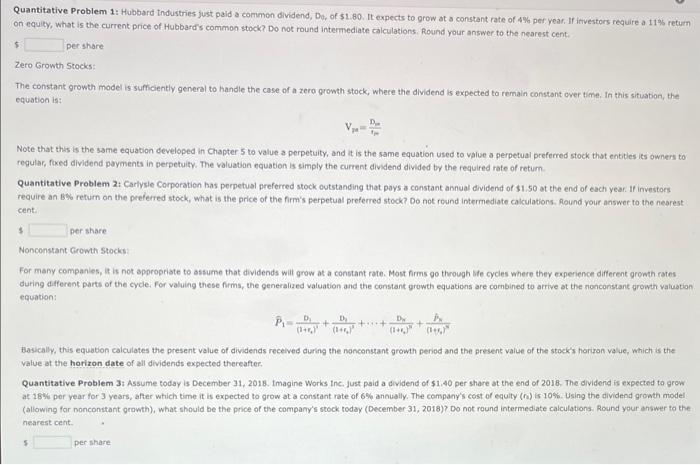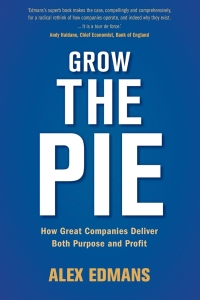Basic Stock Valuation: Dividend Growth Model The value of a share of common stock depends on the cash flows it is expected to provide, and those flows consist of the dwidends the investor recelves each year while holding the stock and the price the invertor receives when the stock is sold. The final price Inchudes the original price paid plus an expected capital gain, The actions of the marginat investor determine the equilibrlum stock brice. Market equil brium occurs when the stock's price is ts intriesic value. If the stock market is reasonably efficient, differences between the stock price and intrinsic value should not be very large and they should not persist for very long. When investing in common stocks, an invertor's goul is to purchase stocks that afe undervalued (the price is the stock's intrinsic value) and avold stocks that are overvalued. The value of a stock today can be calculated as the present value of stream of dividends: (1+rj)2Di+(1+r+)2Dj++(1+L++D=i=1(1+ri)1D1 This is the generalized stock valuation model. We will now look at 3 different situations where we can adapt this generalzed model to each of these situations to determine a stock's intrinste value: 1. Constant Growth Stocks: 2. Zero Growth stocks: 3. Nonconstant Growth Stocks: Constant Growth Stocks: For many componies it is reasonsble to predict that dividends will grow at a constant rate, so we can rewrite the generalited model as foliows: This is known as the constant growth model or Gordon model, named after Myron J. Gordon who developed aad popularized it. There are severat conditions that must exist before this equstion can be used. First, the required rate of return, fu, must be greater than the long-run growth rate, 9 . Second, the coostant growth model is not appropriate unless a company's growth rate is expected to remain constant in the future. This condition almost never holds for irms, but it does exist for many comparites. Which of the following assumptions would cause the constant growth stock valuation model to be invalid? a. The growth rate is zero. b. The growth rate is negative: c. The required rate of return is greater than the growth rate. d. The cequired rate of retum is more than 50%. e. None of the above assumptions wouid invalidate the model: Quantitative Problem 1: Hubbard industries just paid a common dividend, Do, of $1. 80 . It expects to grow at s constant rate of 4% per year, If investors require a I1 on equity, What is the currenk price of Hubbard's common-stock? Do not round intermediate calculations. Round your answer to the nearest cent. 5. per share Zero Growth Stocks: The constant growth model is sufficiently general to handle the case of a zero growth stock, where the dividend is expected to remain canstant over time. In this situabon, the equation is: Vmt=TimDem Note that this is the same equation developed in Chapter 5 to value a perpetuity, and it is the same equation used to value a perpetual preferred stock that entiles its owners to regular, foxed dividend payments in perpetuity. The valuation equation is simply the current dividend divided by the fequired rate of return. Quantitative Problem 2: Carfysie Corporation has perpetual preferred stock outstanding that pays a constant annual dividend of s1. 50 at the end of each year. If investors require an Bw retum on the preferred stock, what is the price of the firm's perpetual preferred stock? Do not round intermediate calculations. Round your answer to the nearest cent: per share Nonconstant Growth Stocks For many companles, it is not appropriate to assume that dividends wilt grow at a constant rate. Most firms go through life cycles where they experience different gromth rates during different parts of the cycle. For valuing these frms, the generalized valuation and the constant growth equations are cornbined to arrive at the nonconstant growth valuation equation: P1=(1+r4)3b1+(1+r4)3b1++(1+r4)3Di+(1+v0)3B^n Easically, this equation calculates the present value of dividends received during the nonconstant gromth period and the present value of the stock's horizon value, which is the value at the horizon date of all dividends expected thereafter. Quantitative Problem 3t Assume today is December 31, 2018. Imagine Worhs inc. Just paid a dividend of \$1.40 per share at the end of 2018. The dividend is expected ta grow (allowing for nonconstant growth), what should be the price of the company's stock today (December 31,2018 )? Do not round intermediate calculations. Round your answer to the nearest cent. 5 per share








